stop start Hyundai Elantra 2005 User Guide
[x] Cancel search | Manufacturer: HYUNDAI, Model Year: 2005, Model line: Elantra, Model: Hyundai Elantra 2005Pages: 256, PDF Size: 10.4 MB
Page 169 of 256
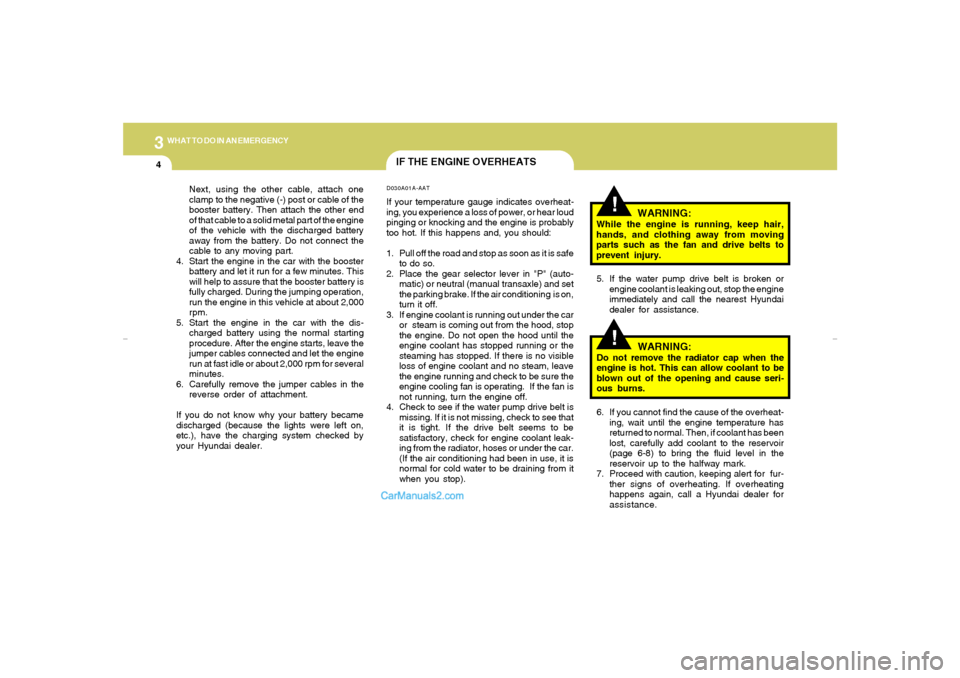
34WHAT TO DO IN AN EMERGENCY
IF THE ENGINE OVERHEATS
!!
WARNING:
While the engine is running, keep hair,
hands, and clothing away from moving
parts such as the fan and drive belts to
prevent injury.
5. If the water pump drive belt is broken or
engine coolant is leaking out, stop the engine
immediately and call the nearest Hyundai
dealer for assistance.
WARNING:
Do not remove the radiator cap when the
engine is hot. This can allow coolant to be
blown out of the opening and cause seri-
ous burns.
6. If you cannot find the cause of the overheat-
ing, wait until the engine temperature has
returned to normal. Then, if coolant has been
lost, carefully add coolant to the reservoir
(page 6-8) to bring the fluid level in the
reservoir up to the halfway mark.
7. Proceed with caution, keeping alert for fur-
ther signs of overheating. If overheating
happens again, call a Hyundai dealer for
assistance.
D030A01A-AATIf your temperature gauge indicates overheat-
ing, you experience a loss of power, or hear loud
pinging or knocking and the engine is probably
too hot. If this happens and, you should:
1. Pull off the road and stop as soon as it is safe
to do so.
2. Place the gear selector lever in "P" (auto-
matic) or neutral (manual transaxle) and set
the parking brake. If the air conditioning is on,
turn it off.
3. If engine coolant is running out under the car
or steam is coming out from the hood, stop
the engine. Do not open the hood until the
engine coolant has stopped running or the
steaming has stopped. If there is no visible
loss of engine coolant and no steam, leave
the engine running and check to be sure the
engine cooling fan is operating. If the fan is
not running, turn the engine off.
4. Check to see if the water pump drive belt is
missing. If it is not missing, check to see that
it is tight. If the drive belt seems to be
satisfactory, check for engine coolant leak-
ing from the radiator, hoses or under the car.
(If the air conditioning had been in use, it is
normal for cold water to be draining from it
when you stop). Next, using the other cable, attach one
clamp to the negative (-) post or cable of the
booster battery. Then attach the other end
of that cable to a solid metal part of the engine
of the vehicle with the discharged battery
away from the battery. Do not connect the
cable to any moving part.
4. Start the engine in the car with the booster
battery and let it run for a few minutes. This
will help to assure that the booster battery is
fully charged. During the jumping operation,
run the engine in this vehicle at about 2,000
rpm.
5. Start the engine in the car with the dis-
charged battery using the normal starting
procedure. After the engine starts, leave the
jumper cables connected and let the engine
run at fast idle or about 2,000 rpm for several
minutes.
6. Carefully remove the jumper cables in the
reverse order of attachment.
If you do not know why your battery became
discharged (because the lights were left on,
etc.), have the charging system checked by
your Hyundai dealer.
xdflhma-3.p652/5/2008, 2:10 PM 4
Page 199 of 256
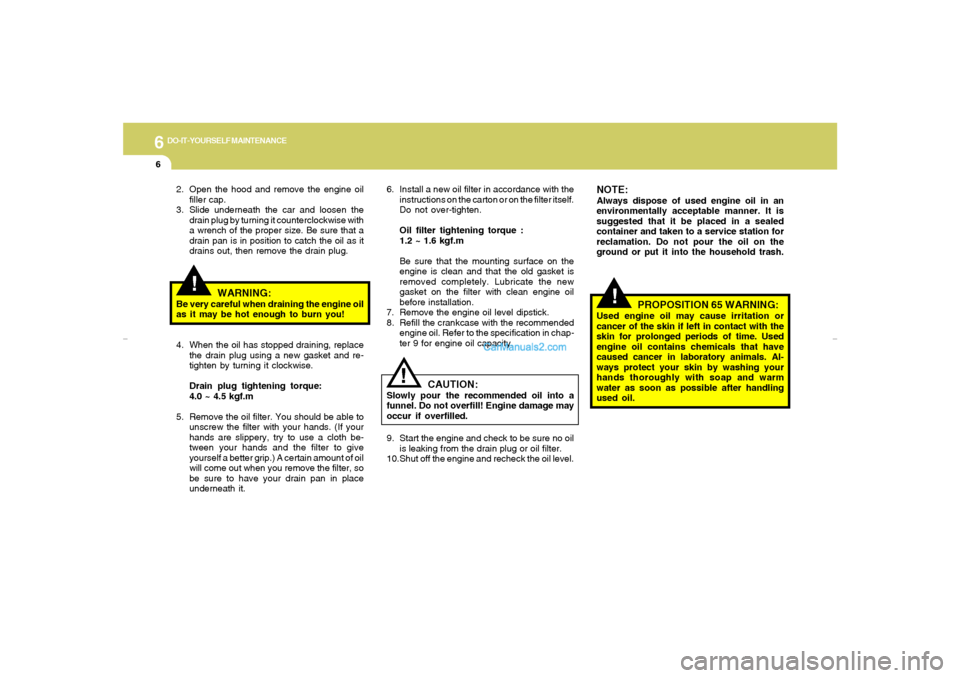
6
DO-IT-YOURSELF MAINTENANCE6
!
!
6. Install a new oil filter in accordance with the
instructions on the carton or on the filter itself.
Do not over-tighten.
Oil filter tightening torque :
1.2 ~ 1.6 kgf.m
Be sure that the mounting surface on the
engine is clean and that the old gasket is
removed completely. Lubricate the new
gasket on the filter with clean engine oil
before installation.
7. Remove the engine oil level dipstick.
8. Refill the crankcase with the recommended
engine oil. Refer to the specification in chap-
ter 9 for engine oil capacity.
PROPOSITION 65 WARNING:
Used engine oil may cause irritation or
cancer of the skin if left in contact with the
skin for prolonged periods of time. Used
engine oil contains chemicals that have
caused cancer in laboratory animals. Al-
ways protect your skin by washing your
hands thoroughly with soap and warm
water as soon as possible after handling
used oil.
9. Start the engine and check to be sure no oil
is leaking from the drain plug or oil filter.
10.Shut off the engine and recheck the oil level.
CAUTION:
Slowly pour the recommended oil into a
funnel. Do not overfill! Engine damage may
occur if overfilled.
NOTE:Always dispose of used engine oil in an
environmentally acceptable manner. It is
suggested that it be placed in a sealed
container and taken to a service station for
reclamation. Do not pour the oil on the
ground or put it into the household trash.
!
2. Open the hood and remove the engine oil
filler cap.
3. Slide underneath the car and loosen the
drain plug by turning it counterclockwise with
a wrench of the proper size. Be sure that a
drain pan is in position to catch the oil as it
drains out, then remove the drain plug.
WARNING:
Be very careful when draining the engine oil
as it may be hot enough to burn you!
4. When the oil has stopped draining, replace
the drain plug using a new gasket and re-
tighten by turning it clockwise.
Drain plug tightening torque:
4.0 ~ 4.5 kgf.m
5. Remove the oil filter. You should be able to
unscrew the filter with your hands. (If your
hands are slippery, try to use a cloth be-
tween your hands and the filter to give
yourself a better grip.) A certain amount of oil
will come out when you remove the filter, so
be sure to have your drain pan in place
underneath it.
xdflhma-6.p652/5/2008, 2:13 PM 6
Page 216 of 256
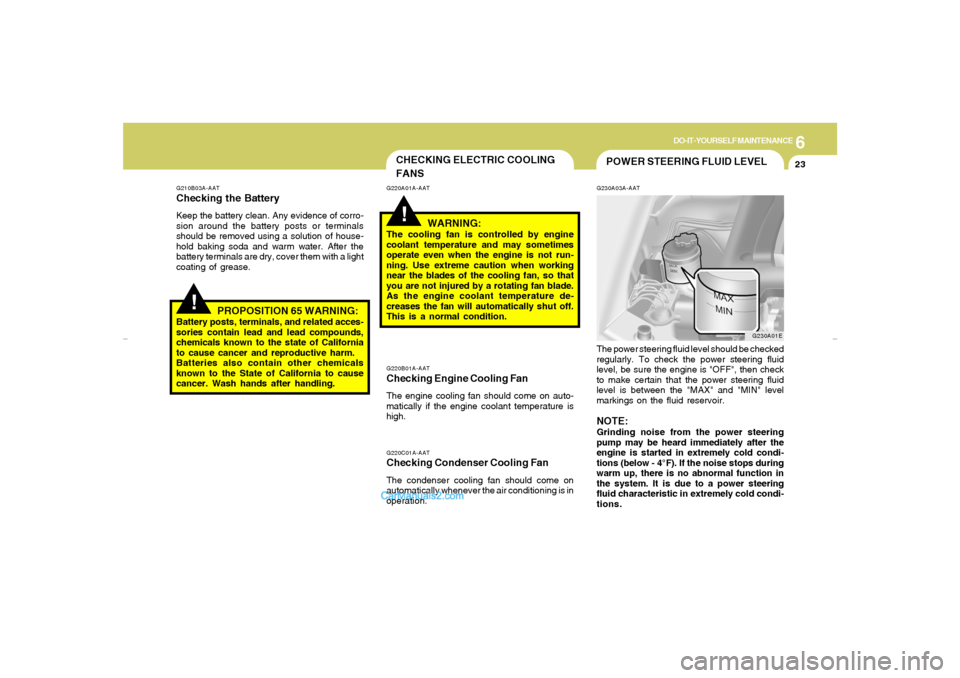
6
DO-IT-YOURSELF MAINTENANCE
23
CHECKING ELECTRIC COOLING
FANS!
!
G220B01A-AATChecking Engine Cooling FanThe engine cooling fan should come on auto-
matically if the engine coolant temperature is
high.G220A01A-AAT
G220C01A-AATChecking Condenser Cooling FanThe condenser cooling fan should come on
automatically whenever the air conditioning is in
operation.
WARNING:
The cooling fan is controlled by engine
coolant temperature and may sometimes
operate even when the engine is not run-
ning. Use extreme caution when working
near the blades of the cooling fan, so that
you are not injured by a rotating fan blade.
As the engine coolant temperature de-
creases the fan will automatically shut off.
This is a normal condition.
G210B03A-AATChecking the BatteryKeep the battery clean. Any evidence of corro-
sion around the battery posts or terminals
should be removed using a solution of house-
hold baking soda and warm water. After the
battery terminals are dry, cover them with a light
coating of grease.
PROPOSITION 65 WARNING:
Battery posts, terminals, and related acces-
sories contain lead and lead compounds,
chemicals known to the state of California
to cause cancer and reproductive harm.
Batteries also contain other chemicals
known to the State of California to cause
cancer. Wash hands after handling.
POWER STEERING FLUID LEVELG230A03A-AATThe power steering fluid level should be checked
regularly. To check the power steering fluid
level, be sure the engine is "OFF", then check
to make certain that the power steering fluid
level is between the "MAX" and "MIN" level
markings on the fluid reservoir.NOTE:Grinding noise from the power steering
pump may be heard immediately after the
engine is started in extremely cold condi-
tions (below - 4°F). If the noise stops during
warm up, there is no abnormal function in
the system. It is due to a power steering
fluid characteristic in extremely cold condi-
tions.
G230A01E
xdflhma-6.p652/5/2008, 2:14 PM 23
Page 228 of 256
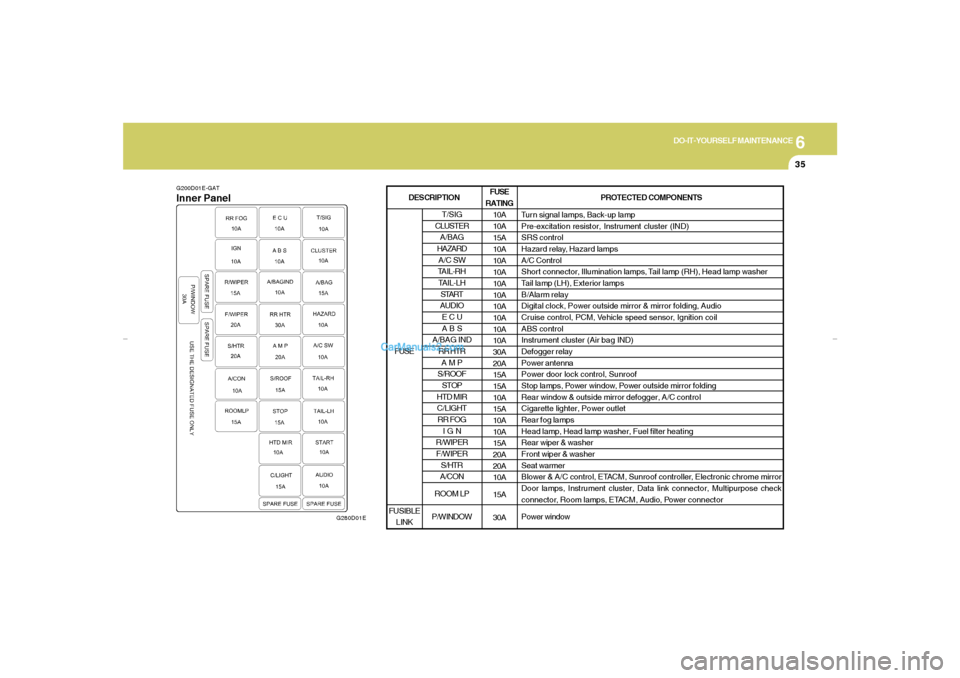
6
DO-IT-YOURSELF MAINTENANCE
35
G200D01E-GATInner Panel
G280D01E
FUSE
RATING
10A
10A
15A
10A
10A
10A
10A
10A
10A
10A
10A
10A
30A
20A
15A
15A
10A
15A
10A
10A
15A
20A
20A
10A
15A
30APROTECTED COMPONENTS
Turn signal lamps, Back-up lamp
Pre-excitation resistor, Instrument cluster (IND)
SRS control
Hazard relay, Hazard lamps
A/C Control
Shor t connector, Illumination lamps, Tail lamp (RH), Head lamp washer
Tail lamp (LH), Exterior lamps
B/Alarm relay
Digital clock, Power outside mirror & mirror folding, Audio
Cruise control, PCM, Vehicle speed sensor, Ignition coil
ABS control
Instrument cluster (Air bag IND)
Defogger relay
Power antenna
Power door lock control, Sunroof
Stop lamps, Power window, Power outside mirror folding
Rear window & outside mirror defogger, A/C control
Cigarette lighter, Power outlet
Rear fog lamps
Head lamp, Head lamp washer, Fuel filter heating
Rear wiper & washer
Front wiper & washer
Seat warmer
Blower & A/C control, ETACM, Sunroof controller, Electronic chrome mirror
Door lamps, Instrument cluster, Data link connector, Multipurpose check
connector, Room lamps, ETACM, Audio, Power connector
Power window
T/SIG
CLUSTER
A/BAG
HAZARD
A/C SW
TAIL-RH
TAIL-LH
START
AUDIO
E C U
A B S
A/BAG IND
RR HTR
A M P
S/ROOF
STOP
HTD MIR
C/LIGHT
RR FOG
I G N
R/WIPER
F/WIPER
S/HTR
A/CON
ROOM LP
P/WINDOW FUSE
FUSIBLE
LINK
DESCRIPTION
xdflhma-6.p652/5/2008, 2:15 PM 35
Page 231 of 256

7
EMISSION CONTROL SYSTEMS
3
CATALYTIC CONVERTER
!
!
WARNING:
o Use unleaded fuel only.
o Maintain the engine in good operating
condition. Extremely high catalytic con-
verter temperatures can result from im-
proper operation of the electrical, igni-
tion or multiport electronic fuel injec-
tion.
o If your engine stalls, pings, knocks, or is
hard to start, have your Hyundai dealer
inspect and repair the problem as soon
as possible.
o Avoid driving with a very low fuel level.
Running out of gasoline may cause the
engine to misfire and result in damage to
the catalytic converter.
o Avoid idling the engine for periods
longer than 10 minutes.
o The vehicle should not be pushed or
pulled to get started. This may cause the
catalytic converter to overheat and cre-
ate a fire hazard.
o Do not touch the catalytic converter or
any other part of the exhaust system
while the catalytic converter is hot. Shut
off the engine, wait for at least one hour
before touching the catalytic converter
or any other part of the exhaust system.
o Remember that your Hyundai dealer is
your best source of assistance.
H020A01S-AATAll Hyundai vehicles are equipped with one or
two monolith type three-way catalytic convert-
ers to reduce the carbon monoxide, hydrocar-
bons and nitrogen oxides contained in the ex-
haust gas. Exhaust gases passing through the
catalytic converter cause it to operate at a very
high temperature. The introduction of large
amounts of unburned gasoline into the exhaust
may cause the catalytic converter to overheat
and create a fire hazard. This risk may be
reduced by observing the following:
WARNING:
o Do not stop your Hyundai over any com-
bustible material such as grass, paper,
leaves or rags. These materials might
contact the hot catalytic converter and a
fire might result.
HXDFL1032
Catalytic Converter
(Federal, California)Catalytic Converter
(California)
xdflhma-7.p652/5/2008, 2:15 PM 3
Page 253 of 256
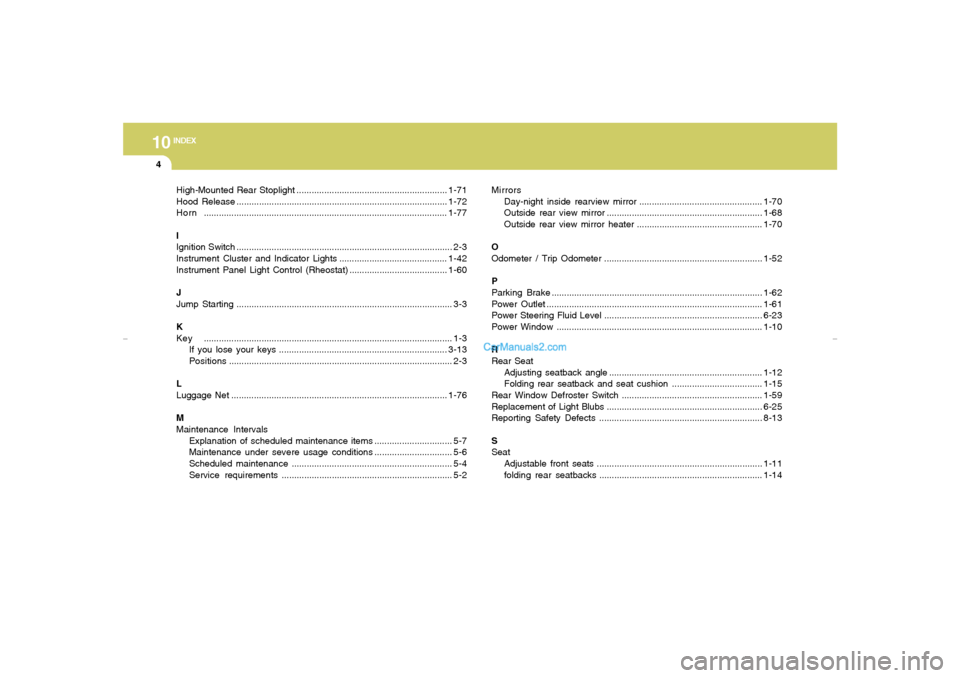
10
INDEX
4
High-Mounted Rear Stoplight ............................................................1-71
Hood Release....................................................................................1-72
Horn.................................................................................................1-77
I
Ignition Switch ...................................................................................... 2-3
Instrument Cluster and Indicator Lights...........................................1-42
Instrument Panel Light Control (Rheostat).......................................1-60
J
Jump Starting...................................................................................... 3-3
K
Key ................................................................................................... 1-3
If you lose your keys ...................................................................3-13
Positions......................................................................................... 2-3
L
Luggage Net ......................................................................................1-76
M
Maintenance Intervals
Explanation of scheduled maintenance items ............................... 5-7
Maintenance under severe usage conditions............................... 5-6
Scheduled maintenance................................................................ 5-4
Service requirements.................................................................... 5-2Mirrors
Day-night inside rearview mirror .................................................1-70
Outside rear view mirror ..............................................................1-68
Outside rear view mirror heater..................................................1-70
O
Odometer / Trip Odometer ...............................................................1-52
P
Parking Brake....................................................................................1-62
Power Outlet......................................................................................1-61
Power Steering Fluid Level ...............................................................6-23
Power Window..................................................................................1-10
R
Rear Seat
Adjusting seatback angle .............................................................1-12
Folding rear seatback and seat cushion ....................................1-15
Rear Window Defroster Switch ........................................................1-59
Replacement of Light Blubs ..............................................................6-25
Reporting Safety Defects .................................................................8-13
S
Seat
Adjustable front seats ..................................................................1-11
folding rear seatbacks.................................................................1-14xdflhma-10.p652/5/2008, 2:18 PM 4